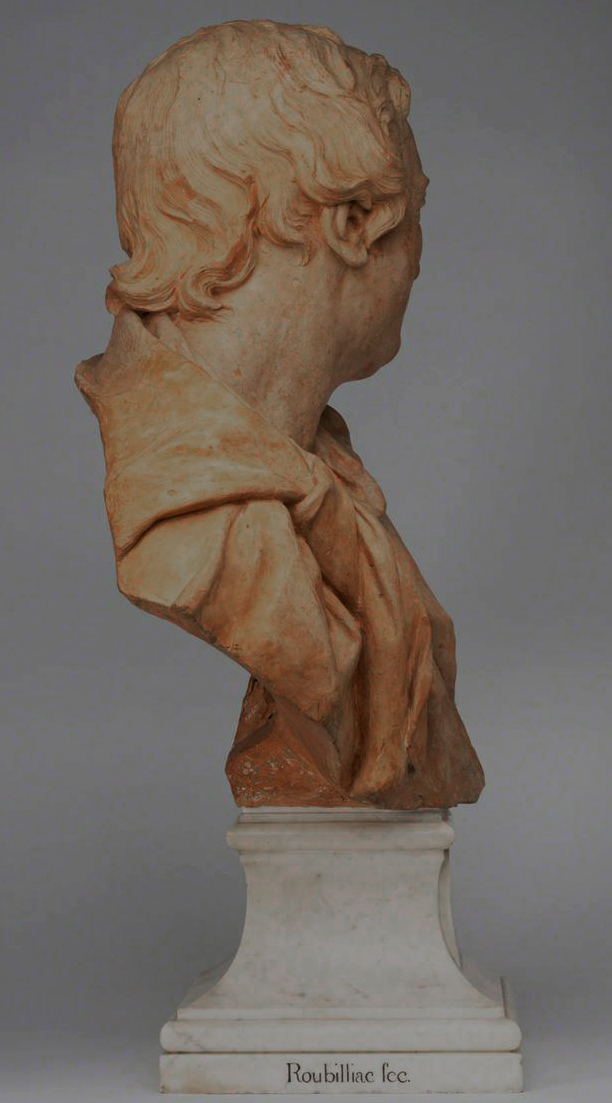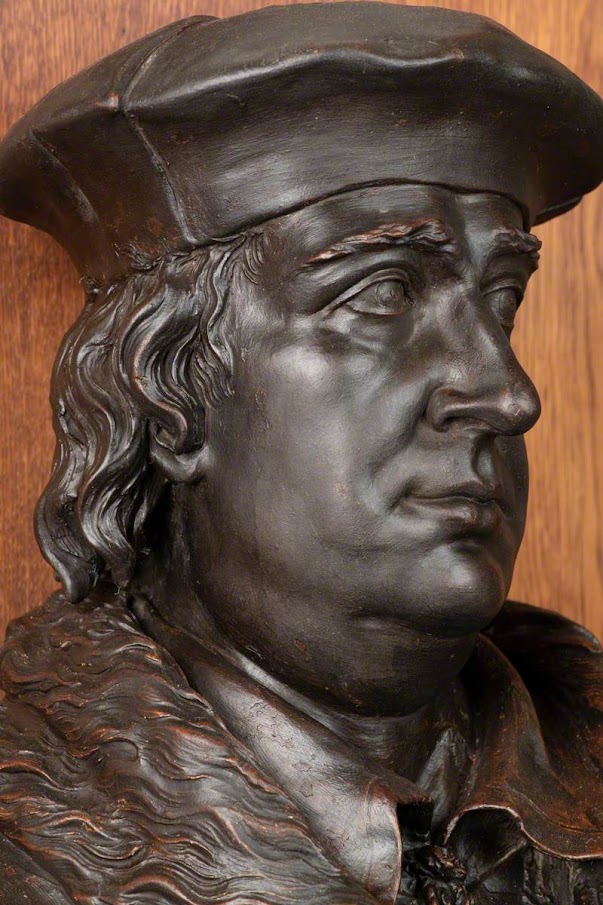This post is still currently under construction.
Henry Herbert 9th Earl of Pembroke,
A Terracotta Bust by Roubiliac.
in the Fitzwilliam Museum, Cambridge.
These rather indifferent photographs below were recently added to the Art UK website.
It is a great shame that these photographs are so poor - hopefully next time I an in Cambridge I will be able to see and photograph this bust myself.
Currently their website is quite difficult to navigate to unless saved to favourites.
The socle is almost certainly a slightly later addition
nb. the spelling of Roubiliac.
Acquisition: bequeathed; 1816; Fitzwilliam, Richard, 7th
Viscount.
Provenance:
Henry Herbert, 9th Earl of Pembroke, FRS (1693-1749/50; Countess of Pembroke, his widow; ? ; Richard, 7th Viscount Fitzwilliam of Merrion (d. 1816).
Notes:
The 9th Earl of Pembroke married Mary Fitzwilliam in 1733 ,
sister of the 6th Viscount Fitzwilliam, whose heir, Richard, was the founder of
the Fitzwilliam Museum.
Ref. p. 91, note 4, says the inscription 'Roubilliac [sic] fec' is modern. 'The model passed first to the Countess's family, then to Cambridge along with the Hercules (pl: XIII b and now atrributed to Rysbrack R.A.B.) and the antique head of Agrippina with a pedestal by Roubiliac (Arnold's Library of the Fine Arts iv, 183, p. 1840).'
The marble bust, for which this was the model, and that of the Countess are at Wilton in the church; there is another of Lord Pembroke in Wilton House, and one at the Birmingham City Museum and Art Gallery.??
Mr Gunnis's records there is a bill from Roubiliac for the bust in the church
see my blog entry: - https://english18thcenturyportraitsculpture.blogspot.com/2019/07/bust-hamilton-orkney-rysbrack.html?m=0
__________________
Henry Herbert, 9th Earl of Pembroke (and 6th Earl of
Montgomery), FRS.
Louis Francois Roubiliac.
Circa 1749.
Depicted facing to sinister; on an integral square marble
socle carved with the Pembroke coat of arms and inscribed ‘VNG. GP. SERVERAY’.
Photograph courtesy Lullo Pampoulides.
24 5/8 in. (62.5 cm.) high
32¼ in. (82 cm.) high overall, including socle
Provenance:
Henry Herbert, 9th Earl of Pembroke, by descent to his son
Henry Herbert, 10th Earl of Pembroke;
The bust and parts of the monument moved to the new Church
of St. Mary and St. Nicholas, Wilton, Wiltshire in 1845;
Bust sold (following the grant by the church court of a
faculty for removal) by
17th Earl of Pembroke (heir-at-law of the 9th Earl of
Pembroke, and therefore owner of the bust) in 1997 (via Christie's) to
Professor Ian Craft, by whom sold, 2005, to
Private Collection, London.
This bust was exhibited at the Victoria and Albert Museum, London, in the
Sculpture in Britain Galleries since 2005.
Sold by dealers Lullo - Pampoulides to a private collector, USA.
______________
Extract from the Christie's Sale Catalogue. Lot 83, 2nd
December 1997.
Three versions of the present bust are known. The other two,
one of which is paired by a bust of the Earl's wife, Mary, the eldest daugher
of Richard, Viscount Fitzwilliam, are at Wilton House. Although none is signed,
their attribution to Roubiliac has not been doubted since they were first
discussed by Mrs. Esdaile in her monograph on the sculptor, where she also
referred to a terracotta model of the bust of the Earl in the Fitzwilliam
Museum, Cambridge, bearing a modern inscription, 'Roubilliac [sic] fec.'
(Esdaile, loc. cit.).
More recently, archival research has revealed that Roubiliac
received £165 and a halfpenny in 1751 from the executors of the 9th Earl for
his monument, of which the present bust formed a part (Bindman and Baker, loc.
cit.).
It would appear, however, that the bust may not originally
have been intended for the monument, but was more probably an independent
portrait, which was subsequently enlisted for the task. It was, in any event, certainly in
place as early as 3 July 1754, when it was described by Richard Pococke as
having the form of 'a marble bust as against a pyramid' (Pococke, loc. cit.).
The original form of the monument was considerably modified
when it was transferred from the chancel of the old medieval church at Wilton
in 1845 to its present location in the new church.
The bust has now been replaced by a replica.
Here are some snaps of this bust taken by the author at the Victoria and Albert Museum.
It is my guess that this bust might have spent some time outdoors and has suffered some weathering.
The flesh of the face and the robe have at some point been repolished (to my eye over polished) and then a wax applied which has given the surface a sort of shiny quality
For this marble bust of Pembroke by Roubiliac formerly on the monument in the church of St Mary and St Nicholas at Wilton sold at Christies lot 83 2nd December 1997.
_______________
There was originally a marble pyramid and urn on the monument at one
time which has since disappeared - probably when the medieval church was
remodelled in 1845. It was perhaps at this period that it spent some time outdoors.
see -
https://www.christies.com/lot/lot-a-carved-marble-bust-of-henry-herbert-304181/?
______________
The Bust of the 9th Earl of Pembroke at Wilton House.
and Mary Fitzwilliam Countess of Pembroke.
Roubiliac.
Currently no good close up photographs available - I hope to rectify this in due course.
Photographs below are courtesy Country Life Archives.
The Busts of Andrew Fountaine and Martin Folkes by Roubiliac at Wilton House.
________________































